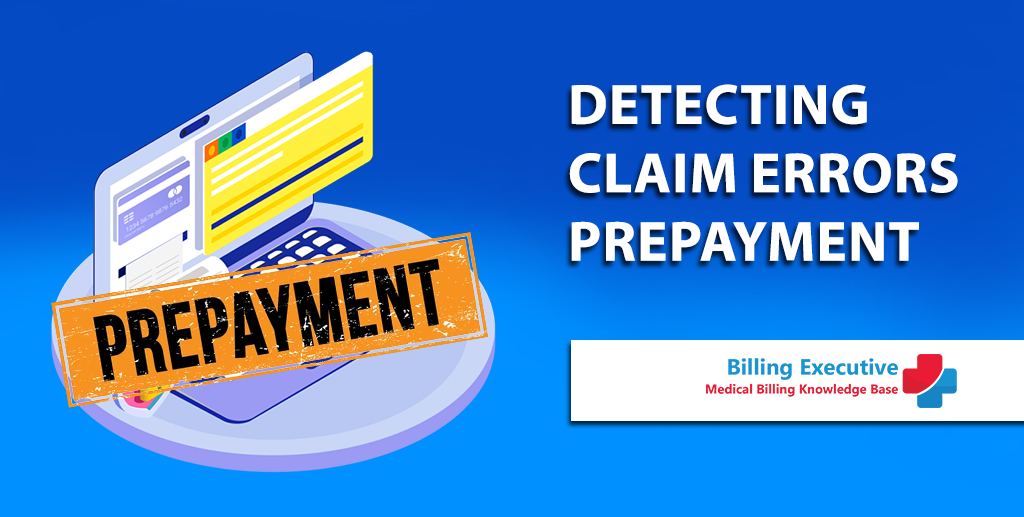Prepayment is an accounting phrase for paying off a debt or installment loan before its formal due date. A prepayment can be a bill settlement, an operating cost, or a non-operating expense that closes an account before its due date. An individual, a business, or any other entity may make a prepayment.

Healthcare prices continue to rise, and revenues remain stagnant; improper claims handling may undoubtedly be blamed. Ineffective claims editing might set off a chain reaction of costly issues. Examples include high error rates, inconsistent claim assessment, regulatory noncompliance fines, and fraud and litigation expenses.
The figures are mind-boggling
- 80% of all claims have coding or other flaws.
- 86% of rejections are possibly preventable, and 34% are completely avoidable.
- Almost all claim denials are never resubmitted.
Claims Editing Software
Pursuing claims income is time-consuming, difficult, and expensive. While assessing clinical coding and editing software, it is critical to select a system that supports payer requirements while allowing for customer rule generation.
Your claims editing software should be able to automatically apply rules and revisions depending on the date of service delivered, allowing you to respond quickly to changes without losing the ability to appropriately modify claims for services performed when an earlier set of rules was in place.
Many practice management systems, EHRs, and clearinghouses have claim editing capabilities. However, procedures cannot rely on basic front-end editing, which merely checks for errors like as missing or poorly formed data. Even systems that examine Medicare local/national coverage decisions or NCCI adjustments may be weak in actual clinical coding edits.
Consider looking for a solution that can edit for the following top denial categories:
- Incorrect CPT or ICD codes
- erroneous coding
- Absence of medical necessity
- Unbundling and upcoding
- Modifiers that are missing or incorrect
Claims Editing Best Practices
Once you’ve decided on the best clinical coding and editing software for your company, it’s time to get started. And, because the easiest way to discover billing issues is to recognize them before payment, here are a few pointers to get you started.
1. Follow the rules in place at the time of service.
Billing codes and their related regulations are constantly changing due to frequent changes in the regulatory atmosphere, Medicare standards, commercial editing rules, and coding systems. As a result, it is critical to revise claims based on the rules and regulations when the provider provides the service. Failure to do so will increase the number of provider appeals.
Payers must modify and pay claims properly and consistently using appropriate rules and codes.
2. Code relationship level source edits
Providers want to know about reductions or denials due to claim revisions. Consumers are no exception, especially since they shoulder a growing expense share. Failure to give such information may subject you to costly appeals or litigation.
Use industry-recognized third-party sources to base your revisions. Document your sources clearly, and explain your adjustments in straightforward language that both clinicians and patients can comprehend.
3. Ensure complete information and transparency
Printing a number on an EOB is not the same as informing someone of what they need to know.
It isn’t only about avoiding litigation. Transparency also means keeping providers and members pleased and providing them with the information they need to understand health care services and reimbursement choices. Transparency is critical to the success of any healthcare business, especially as healthcare becomes more consumer-driven.
When claims are denied, providers and members need to know why and what they may do to appeal the refusal if they disagree.
Your claims editing system should deliver message modifications, rule sources, and disclosure statements to providers and consumers, reducing the effect of any questions and appeals.
4. Integrate the capabilities of the rules engine.
Your claims editing solution should use rules engine technology that includes a full collection of commercial and Medicare changes and rule logic to reduce the amount of human effort needed in adjudicating simple claims.
Payers must be innovative in their new product offerings and contracts to earn new business, with the trend of mergers and acquisitions continuing. Core adjudication and operational systems must enable greater automation and workflow integration to support these new offers.
5. Follow the proper guidelines while modifying facility claims.
Rather than professional services editing, facility claims editing is driven by various claim forms, contracts, and coding regulations. As a result, it’s critical to recognize that professional and facility claims are not the same.
A payer that utilizes professional edits to amend facility claims may run into several issues, including:
- Contractual conflict with providers
- Claim reprocessing
- A high incidence of provider attractiveness
- Loss of network providers is a possibility.
Companies should use a facility-specific claims editing system. Payers can then shorten the claims processing processes while increasing payment accuracy to optimize potential savings.
6. Customize regulations to fit certain areas of business.
One-size-doesn’t-fit-all. Each health plan has its business model, replete with unique provider contracts, member perks, and payment rules. As a result, your claims editing system should be adaptable while still allowing you to manage agreements and respond to regulatory changes at the drop of a hat.
About us
Billing Executive – a Medical Billing and Coding Knowledge Base for Physicians, Office staff, Medical Billers and Coders, including resources pertaining to HCPCS Codes, CPT Codes, ICD-10 billing codes, Modifiers, POS Codes, Revenue Codes, Billing Errors, Denials and Rejections.
We have more than 10 years experience in US Medical Billing and hand-on experience in Web Management, SEO, Content Marketing & Business Development with Research as a special forte.
Learn More
Complete Medicare Denial Codes List – Updated
Common CPT Modifiers To Reduce Denials
CO 119 & PR 119 – Benefit Maximum for this Time Period has been Reached
Denial CO 11: Diagnosis is inconsistent with The Procedure
